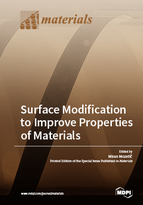Surface Modification to Improve Properties of Materials
A special issue of Materials (ISSN 1996-1944).
Deadline for manuscript submissions: closed (31 December 2018) | Viewed by 116324
Special Issue Editor
Interests: surface engineering; non-equilibrium gaseous plasma; polymers; organic materials; plasma technologies
Special Issues, Collections and Topics in MDPI journals
Special Issue Information
Dear Colleagues,
Surface properties of modern materials are usually inadequate so they should be modified prior to application or further processing such as coating with functional materials. Both morphological properties and chemical structure/composition should be modified in order to obtain a desired surface finish. Various treatment procedures have been employed and many are based on application of non-equilibrium gaseous media, especially gaseous plasma. Although such treatments have been studied extensively in past decades, and actually commercialized, the exact mechanism of interaction between reactive gaseous species and solid materials is still poorly understood. This Special Issue will provide recent trends in nanostructuring and functionalization of solid materials with the goal of improving their functional properties such as biocompatibility.
It is my pleasure to invite you to submit a manuscript for this Special Issue. Full papers, communications, and reviews are all welcome. Critical reviews in specific modern topics such as bio-compatibility of advanced polymers and polymer composites are particularly welcome. The authors are encouraged to submit manuscripts reporting unexpected results providing they can present scientifically spotless explanations.
Prof. Dr. Miran Mozetič
Guest Editor
Manuscript Submission Information
Manuscripts should be submitted online at www.mdpi.com by registering and logging in to this website. Once you are registered, click here to go to the submission form. Manuscripts can be submitted until the deadline. All submissions that pass pre-check are peer-reviewed. Accepted papers will be published continuously in the journal (as soon as accepted) and will be listed together on the special issue website. Research articles, review articles as well as short communications are invited. For planned papers, a title and short abstract (about 100 words) can be sent to the Editorial Office for announcement on this website.
Submitted manuscripts should not have been published previously, nor be under consideration for publication elsewhere (except conference proceedings papers). All manuscripts are thoroughly refereed through a single-blind peer-review process. A guide for authors and other relevant information for submission of manuscripts is available on the Instructions for Authors page. Materials is an international peer-reviewed open access semimonthly journal published by MDPI.
Please visit the Instructions for Authors page before submitting a manuscript. The Article Processing Charge (APC) for publication in this open access journal is 2600 CHF (Swiss Francs). Submitted papers should be well formatted and use good English. Authors may use MDPI's English editing service prior to publication or during author revisions.
Keywords
- surface properties
- nanostructuring
- functionalization
- grafting







